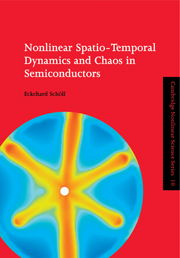Book contents
- Frontmatter
- Contents
- Preface
- Chapter 1 Semiconductors as continuous nonlinear dynamic systems
- Chapter 2 Concepts of nonlinear charge transport in semiconductors
- Chapter 3 Pattern formation and oscillatory instabilities in semiconductors
- Chapter 4 Impact-ionization-induced impurity breakdown
- Chapter 5 Nonlinear carrier dynamics in crossed electric and magnetic fields
- Chapter 6 Stationary and oscillating domains in superlattices
- Chapter 7 Spatio-temporal chaos
- References
- Index
Chapter 1 - Semiconductors as continuous nonlinear dynamic systems
Published online by Cambridge University Press: 17 September 2009
- Frontmatter
- Contents
- Preface
- Chapter 1 Semiconductors as continuous nonlinear dynamic systems
- Chapter 2 Concepts of nonlinear charge transport in semiconductors
- Chapter 3 Pattern formation and oscillatory instabilities in semiconductors
- Chapter 4 Impact-ionization-induced impurity breakdown
- Chapter 5 Nonlinear carrier dynamics in crossed electric and magnetic fields
- Chapter 6 Stationary and oscillating domains in superlattices
- Chapter 7 Spatio-temporal chaos
- References
- Index
Summary
This book deals with complex nonlinear spatio-temporal dynamics, pattern formation, and chaotic behavior in semiconductors. Its aim is to build a bridge between two well-established fields: The theory of dynamic systems, and nonlinear charge transport in semiconductors. In this introductory chapter the foundations on which the theory of semiconductor instabilities can be developed in later chapters will be laid. We will thus introduce the basic notions and concepts of continuous nonlinear dynamic systems. After a brief introduction to the subject, highlighting dissipative structures and negative differential conductivity in semiconductors, the most common bifurcations in dynamic systems will be reviewed. The notion of deterministic chaos, some common scenarios, and the particularly challenging topic of chaos control are introduced. Activator–inhibitor kinetics in spatially extended dynamic systems is discussed with specific reference to semiconductors. The role of global couplings is illuminated and related to the external circuits in which semiconductor elements are operated.
Introduction
Semiconductors are complex many-body systems whose physical, e.g. electric or optical, properties are governed by a variety of nonlinear dynamic processes. In particular, modern semiconductor structures whose structural and electronic properties vary on a nanometer scale provide an abundance of examples of nonlinear transport processes. In these structures nonlinear transport mechanisms are given, for instance, by quantum mechanical tunneling through potential barriers, or by thermionic emission of hot electrons that have enough kinetic energy to overcome the barrier. A further important feature connected with potential barriers and quantum wells in such semiconductor structures is the ubiquitous presence of space charge.
- Type
- Chapter
- Information
- Publisher: Cambridge University PressPrint publication year: 2001



